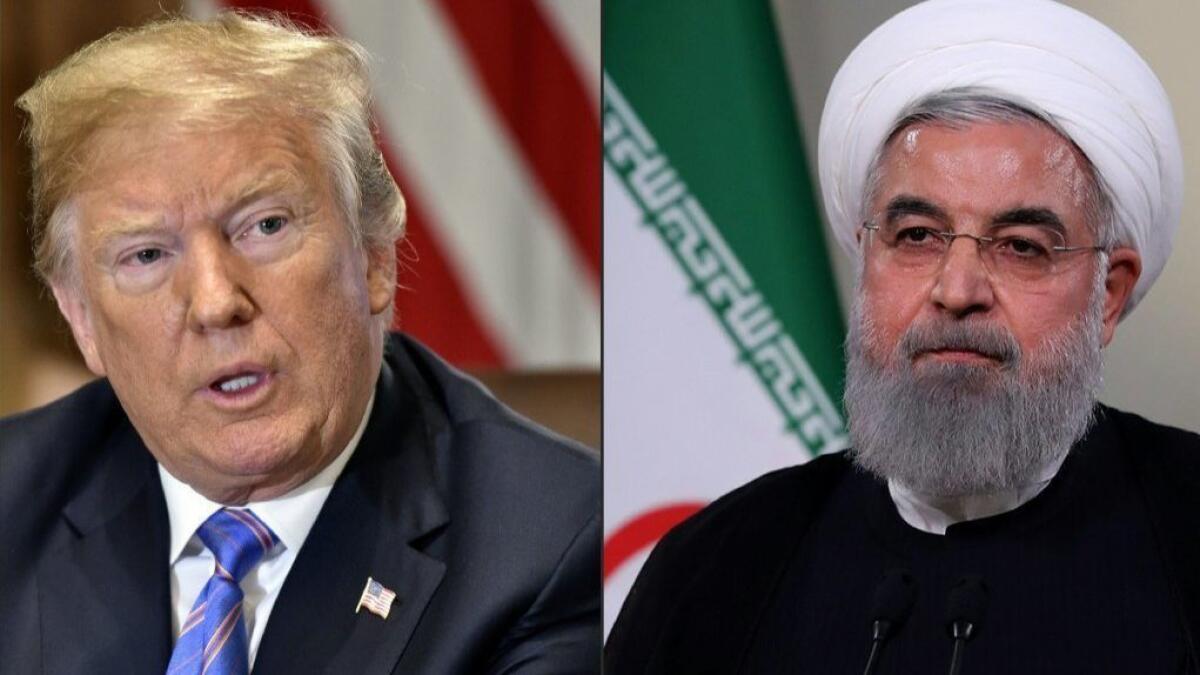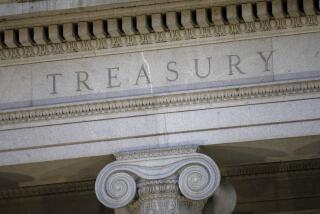Trump reviving tough sanctions on Iran in effort to replace nuclear pact

- Share via
Reporting from Washington — The Trump administration Monday announced it is reimposing harsh economic sanctions on Tehran as part of a strategy to replace the landmark 2015 nuclear deal with what it hopes will be a stronger agreement to curb the Islamic Republic’s ability to build a nuclear bomb.
The new sanctions, which go into effect at 12:01 a.m. EDT Tuesday, target numerous areas of Iranian economic activity. They ban most transactions with Iran’s central bank and the nation’s network of ports and insurance companies; the purchase of Iranian sovereign debt; and trade in autos as well as gold, graphite, aluminum and other precious metals.
In a statement Monday, President Trump called the 2015 pact “a horrible, one-sided deal.” He said it “failed to achieve the fundamental objective of blocking all paths to an Iranian nuclear bomb, and it threw a lifeline of cash to a murderous dictatorship that has continued to spread bloodshed, violence and chaos.”
Supporters of the deal say that, while flawed, it has successfully prevented Iran from acquiring a nuclear weapon in the medium term. United Nations inspectors, whom Iran agreed to admit regularly, say Iran has largely complied with the deal’s restrictions.
Trump’s decision to reinstate sanctions was immediately criticized by countries and groups that support the deal, particularly Iran. Iranian President Hassan Rouhani went on national state television Monday evening to accuse Trump of sacrificing international diplomacy and negotiation to domestic politics.
Trump “has not honored any international commitments, let alone the nuclear deal,” Rouhani said. “Therefore they want to have a psychological war against our people, maybe for their own congressional elections.”
Rouhani rejected an offer from Trump to talk with Iranian leaders as empty pandering. “When somebody calls for negotiations, he must be honest,” Rouhani said.
In a joint statement, several cosignatories to the 2015 pact — the governments of Germany, France, Britain as well as the European Union — said they were gravely disappointed at Trump’s move, and vowed to protect businesses that seek to work in or with Iran.
“Preserving the nuclear deal with Iran is a matter of respecting international agreements and a matter of international security,” the countries said.
Critics argue that Trump’s reneging raises doubts among allies and adversaries on the U.S. commitment to partnerships, promises and leadership.
The original deal required Iran to dismantle its nuclear-production infrastructure, mothballing centrifuges used to enrich uranium, disabling its plutonium-producing heavy-water reactor and getting rid of nearly its entire stockpile of enriched uranium.
In exchange, crippling U.N. sanctions on Iran were eased and billions of dollars in Iranian assets were unfrozen and returned. Tehran was allowed to rejoin the world economy, trading oil and participating in financial markets.
In addition to the European countries, Russia and China were party to the deal with the U.S. and Iran.
Trump disdained the deal, saying it did not do enough to curb Iran’s “malign behavior,” including support for militant groups in Gaza Strip, Syria and Yemen, as well as repression of domestic opposition.
In May, Trump withdrew from the deal, despite intense lobbying from Europe not to do so. Europeans and others said they will attempt to keep the deal alive, but they risk being penalized by Washington if their companies continue to do business with Iran.
“Individuals or entities that fail to wind down activities with Iran risk severe consequences,” Trump warned Monday. “We urge all nations to take such steps to make clear that the Iranian regime faces a choice: either change its threatening, destabilizing behavior and reintegrate with the global economy, or continue down a path of economic isolation.”
Administration officials, who briefed reporters Monday on condition of anonymity, rejected the criticism that the revived U.S. sanctions will be less effective than the earlier Obama-era package because none of the other key world leaders are onboard.
“We’ve seen … company after company after company getting out [of Iran], so there’s no doubt [pressure] is working,” a senior administration official said.
Veteran Iran watchers say Washington’s demands are tantamount to seeking a new government in Tehran or urging Iranians to overthrow their leaders. The officials denied that was the Trump administration’s goal.
“Our stated policy is not to bring about regime change but to change behavior of the regime,” said one of the officials. Another official added that, “The Iranian people are seeking the same thing.”
Secretary of State Michael R. Pompeo, speaking on the eve of Monday’s announcement, said Washington is determined to enforce the sanctions.
“These folks are bad actors and the president is determined to change their direction,” Pompeo told a small group of reporters traveling with him to Washington from a regional conference in Singapore. “They’ve got to behave like a normal country. That’s the ask. It’s pretty simple.”
A second batch of sanctions that will more directly target Iran’s petroleum industry is set to go into effect in 90 days.
Rouhani said he was confident Russia and China will continue to trade with Iran. And countries like India and Japan are major importers of Iranian oil. Some countries sought waivers from Washington so they could trade with Tehran, but it is not yet evident that any have been granted.
On the streets of Tehran, residents also voiced pessimism about the economy — blaming both Trump and their own government — and said they anticipated worse days to come.
Morteza, a 40-year-old wholesaler of kitchen products who did not want to give his last name, said, “Trump wants regime change but regime change is impossible — only the people are suffering.”
Morteza said he blamed skyrocketing prices on Trump’s withdrawal from the nuclear deal, and many residents echoed fears that sanctions will only add to the problems caused by their government’s economic mismanagement.
“People are unable to make ends meet,” said Morad Akbari, a stubble-faced 37-year-old who sells small appliances out of the back of his van. “How can I be hopeful?”
Manchehr Zangovi, a 64-year-old retired math teacher and accountant, said he had turned to driving a taxi because his pension couldn’t pay the bills.
Rouhani “wants to inject hope in the hearts and minds of the people, but it’s too late,” the gray-bearded Zangovi said. “We are heading to a dead-end economy and we are doomed.”
In recent days, scattered anti-government protests have broken out in cities across Iran, with demonstrators calling for the departure of Supreme Leader Ayatollah Ali Khamenei, according to videos circulated on social media.
In separate videos purportedly shot in the northern province of Albourz last week, small groups of demonstrators were seen hurling stones at riot police and gathering under a bridge shouting, “Death to Khamenei.”
The protests were widespread enough that the semiofficial Fars news agency carried a news story but emphasized that the protesters were agitating about rising prices.
The chants echoed those heard in larger protests in December and January, which prompted a heavy-handed security crackdown.
In his comments Monday night, Rouhani said he had no concerns about the stability of the Iranian theocracy, asserting that Iran’s cohesion was “beyond doubt.”
Wilkinson reported from Washington and Bengali from Mumbai, India. Special correspondent Ramin Mostaghim contributed from Tehran.
For more on international affairs, follow @TracyKWilkinson on Twitter
UPDATES:
1:55 p.m.: This article was updated with reaction from Iran and other nations.
8:25 a.m.: This article was updated with Trump’s statement.
This article was originally published at 7:30 a.m.
More to Read
Sign up for Essential California
The most important California stories and recommendations in your inbox every morning.
You may occasionally receive promotional content from the Los Angeles Times.












